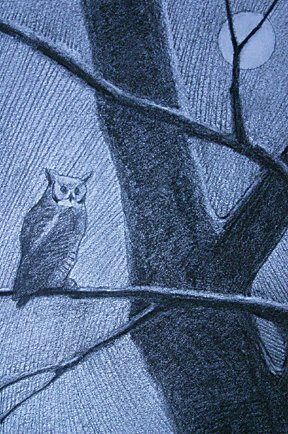
|
Volume 16, Issue 48 - November 27 - December 3, 2008
|
|
Columns |
 |
Earth Journal by Gary Pendleton

The Great Horned Owl
Their call carries far through the nearly naked trees
It was nighttime in early November. From somewhere down by the Creek, a great horned owl sent a not-so-loud but oh-so-deep call that carried a long way. The sound murmured through the woods, to the field and across the road, as far as the trees at the edge of the far field. Not quite a mile; let’s call it a country mile. My voice could not carry so far, even if I shouted.
You have looked across the Bay to the Eastern Shore, and I would guess that you’ve traveled west toward the Appalachian Mountains. When you look at the distant shore or mountains, what color do you see? They don’t call it the Blue Ridge for nothing. The blue color notes are analogous to the call of the great horned owl.
Up close, the color of the land is full spectrum. But from a distance, what you mostly see is blue. Blue and violet are the light spectrum’s version of bass notes.
Sound and light are waves. The longer the wave-length, the more durable it is and the farther it will travel. I am not a physicist so I will back off this particular limb before I demonstrate my ignorance. I am a landscape painter, however, and therefore preoccupied with the problem of how to make the distant hills look far away. Simply put, I’ve learned to mix a pale blue-gray to show aerial perspective, to call it by its technical term.
I understand how the owl sends its voice across long distances. But why? There must be a need, but I have looked for an answer in my small library of bird books and found nothing. So, having risked critical letters from the physicists and artist readers of Bay Weekly, let me tempt the biologists, too, by suggesting the why.
Owls are top predators; nobody messes with them. They feed on rodents, birds and insects. It takes a lot of small critters to feed an owl family, so they need a large territory.
They also need to communicate. Males send out calls to attract potential mates as well as to warn male competitors to keep their distance. Being denizens of the forest, the owls need a powerful and deep voice to penetrate the dense woods and carry far enough to reach the potential mates who are, because of their relative rarity, scattered as far as the trees at the edge of the field across the road.